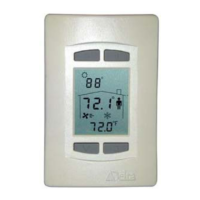Delta Controls
Document Edition 3.1
Page 29 of 35
The Algorithm estimates the position of the Tri-state device by mapping run time against desired percent
open/closed. Therefore it is important to enter an accurate runtime parameter. The algorithm also has an internal
dead band of 6% to minimize hunting of the valve position.
If a reverse acting valve is to be used, cross connect the Open and Close outputs.
5. F
AN CONTROL
There are three modes of operation:
Fan Type Occupied Mode Unoccupied Mode
Continuous Fan ON constantly. ON when the Controller is not in
deadband for night setback.
Intermittent Fan ON when the Controller is not in
deadband. O
FF in deadband.
O
N when the Controller is not in
deadband for night setback.
Manual Fan Fan ON and OFF controlled by user
button presses.
ON when the Controller is not in
deadband for night setback.
If Fan is selected it is always connected to Output 3, and can be configured for reverse or direct acting. Setup
variable AV28 is the Fan delay value in seconds, which is used for ‘delay off’. [In some cases the fan should be
connected to OP1 and configured as the 1st stage of heating, not as a fan – see the note below.]
Each configuration has a specific sequence of operation that is tailored to control that type of terminal unit.
Note that the fan is single speed O
N/ OFF control. With the a limited number of outputs, neither the DNT-T103
nor the DNT-T221 support 2 or 3 speed fans in any of the built-in control strategies. If you need to control a FCU
or other equipment with multi-speed fans, you will need to connect the BACstat to a LINKnet network, disable
local control applications and write your own fan control program in the DAC the BACstat is connected to.
When the application is set to FCU on a DNT-T103 and the fan type is Intermittent, the fan will start when the
first stage controller value for heating or cooling becomes greater than 99.9%. When the first stage controllers for
heating and cooling both become less than 1% and the Output 3 Binary Delay (AV28) has timed out, the fan
output will be turned off. [Only exists in Release 2 Firmware and higher.]
When the application is set to HPU on a DNT-T103 and the fan type is Intermittent, the fan will start when the
compressor starts. When the compressor stops and the Output 3 Binary Delay (AV28) has timed out, the fan
output will be turned off. [Only exists in Release 2 Firmware and higher.]
NOTE: For fan-powered boxes series fans should always be configured for continuous
operation – never intermittent or the fan could run backwards on startup. And, in order for
a parallel fan to be properly sequenced it should generally be configured as the 1st stage of
heating (and wired to OP1), rather than as a fan.
6. ANALOG (DNT-T221 ONLY)
Only the DNT-221 supports two analog outputs, which provide a 0 to 10v signal. Selecting Outputs 1 &2 as
analog are not even options in the Configuration Menu for the DNT-T103.
For VAV and VVT, Output 1 is configured as an analog damper (flow for VAV and cooling for VVT). The other
analog output may be configured as a modulating output for auxiliary heating or cooling. Due to the internal
controller logic, an analog flow damper also requires that an appropriate runtime be set for the actuator (via Setup
variable AV24), which is set to control the speed with which the damper will move and needs to be equal to or
greater than the actual run time of the analog actuator. Analog outputs for auxiliary heating or cooling do not
have an associated runtime setting.
If the application is something other than VAV or VVT, then both analog outputs may be configured for either
heating or cooling. Analog outputs for heating or cooling may be either direct or reverse acting.
Note that for the HPU application, rather than modulating the two analog outputs, 2-position control is provided
for the compressor and reversing valve, either 0 or 10v (typically requiring an appropriate interface relay).

